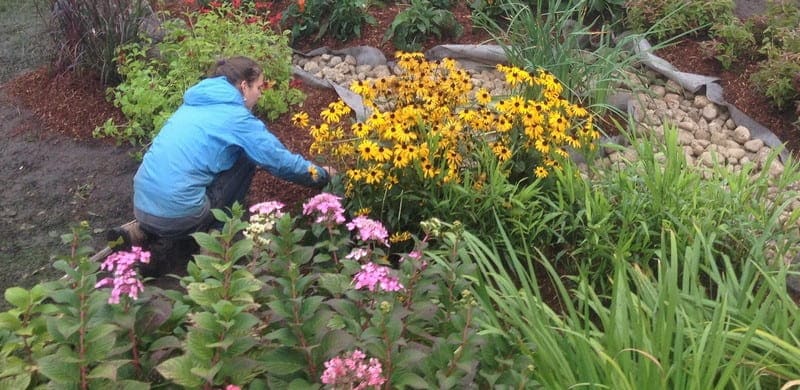
A rain garden is a shallow, planted depression that collects stormwater from roofs, patios, paths, or lawn, then lets it soak into the ground. Done right, it reduces puddles and erosion, filters pollutants, and invites pollinators—while looking like a natural planting bed. If you’re wondering how to build a small rain garden, this step-by-step guide covers site reading, sizing, soil prep, planting, and upkeep.
1) Read Your Site
Follow the water. After a steady rain, watch where sheet flow travels and where it collects. Choose a spot where you can intercept flow before it reaches low lawn areas or hardscape.
Keep safe distances.
- Stay 3–4.5 m (10–15 ft) away from building foundations/basements.
- Avoid septic systems and large tree trunks/root flares.
- Pick a location that can overflow safely onto lawn or another planted area.
Drainage goal. A good rain garden drains within 24–48 hours after a storm. Longer than that? Improve the soil, reduce inflow, or choose a different spot.
2) Size It (Quick Rules)
You don’t need engineering math for a small garden. Use these starter rules and refine later:
- Area: aim for ~7–10% of the hard surface draining to it.
Example: 40 m² of roof edge → 3–4 m² rain garden. - Depth: 10–20 cm (4–8 in) from rim to floor.
- Side slopes: 3:1 or flatter (every 30 cm horizontal, ~10 cm vertical) for stability and easy maintenance.
- Inlet: a shallow, stone-lined notch or channel 45–60 cm (18–24 in) wide to slow water.
- Overflow: a second stone-lined notch at the low edge directing excess away from structures.
3) Test and Prep the Soil
Simple percolation test.
Dig a hole 20–30 cm (8–12 in) deep in the chosen spot. Fill with water and let it drain once to pre-wet. Refill and time the drop:
- ≥ 2.5 cm (1 in) per hour: ideal—proceed.
- Slower: blend in organic matter and a bit of mineral structure; consider a wider, shallower basin.
Amend, don’t layer.
Work 5–8 cm (2–3 in) of compost into the top 20–25 cm (8–10 in) of soil across the basin. In heavy clay, add a modest amount of angular grit or coarse sand to improve structure—avoid creating distinct layers that can impede flow.
Mulch that stays put.
Use shredded hardwood or washed pea gravel (5–7 cm / 2–3 in). Bark nuggets float; skip them inside the bowl.
4) Shape and Build (Weekend Workflow)
- Lay out the outline with a hose or marking paint. Include inlet and overflow in your sketch.
- Remove turf and set aside usable topsoil.
- Excavate shallowly, sculpting gentle, walkable side slopes into a level basin floor (level side-to-side so water spreads).
- Blend amendments (compost/grit) into the upper soil profile; rake smooth.
- Armor the inlet and overflow with geotextile (optional) and 5–10 cm (2–4 in) rounded stone to prevent scour.
- Install edging (steel, brick, stone) if you want a crisp rim and tidy mulch line.
- Water-test with a hose to see how the flow enters, spreads, and exits. Adjust now.
5) Planting Plan That Works
Think in rings from wet center to drier rim, mixing root types for structure and resilience. Favor native species suited to your region.
Center (wettest, temporary inundation):
- Sedges (Carex spp.), rushes (Juncus spp.)
- Blue flag iris (Iris versicolor), cardinal flower (Lobelia cardinalis)
- Marsh blazing star (Liatris spicata), swamp milkweed (Asclepias incarnata)
Mid-slope (moist to mesic):
- Coneflower (Echinacea), bee balm (Monarda), black-eyed Susan (Rudbeckia)
- Goldenrod (Solidago), aster (Symphyotrichum), obedient plant (Physostegia)
Rim (drier edge):
- Little bluestem (Schizachyrium scoparium), switchgrass (Panicum virgatum)
- Compact shrubs like sweetspire (Itea virginica), inkberry (Ilex glabra) or spirea (Spiraea spp.)
Design notes
- Mix heights and textures for four-season interest and habitat.
- Stagger bloom times (spring–fall) to support pollinators.
- Space plants closely (30–45 cm / 12–18 in) to knit soil and shade weeds by the second season.
6) Connect the Water—Gently
- From roofs: use a shallow swale or a buried solid pipe to carry downspout flow to the inlet. Maintain positive slope away from the house.
- From patios/paths/lawn: shape a shallow grass swale that feeds the basin; avoid steep, fast channels.
- Energy dissipation: always land the flow on stone at the inlet.
7) Maintenance (Light but Regular)
- After big storms (first season): rake mulch back where it drifted, top up low spots, and clear the inlet/overflow.
- Spring/Fall: cut back spent stems (leave some seed heads for birds), remove weeds, refresh 2–3 cm (1 in) of mulch.
- Watering: treat year one like any new planting—deep water during prolonged dry spells.
- Editing: by year two, thin vigorous spreaders and fill any gaps.
8) Troubleshooting
- Water stands >48 hours: widen/shalllow the basin, add more organic matter and structure, or reduce inflow. Confirm the overflow isn’t blocked.
- Scour at inlet: enlarge the stone splash pad and flatten the approach grade.
- Mulch float-off: switch to shredded hardwood or pea gravel; avoid bark nuggets inside the bowl.
- Plants failing: move sensitive species upslope; use tougher wet-center choices in the middle.
9) Tools, Materials, and Cost Snapshot
Tools: shovel/spade, digging fork, rake, wheelbarrow, hand tamper, string level, hose.
Materials: compost, shredded hardwood or pea gravel, river rock for inlet/overflow, edging (optional), plants (typically 12–30 for a mini garden).
Time: a focused weekend for a 2–4 m² garden with one or two people.
Common Mistakes to Avoid
- Too deep, too steep. Keep depth modest and side slopes gentle; steep bowls erode and are hard to maintain.
- No overflow plan. Always provide a safe exit path.
- Planting only showy perennials. Mix grasses/sedges for structure and year-round cover.
- Floating mulch. Choose mulch that locks together or switch to pea gravel inside the bowl.
- Right plant, wrong place. Put moisture lovers in the center; drought-tolerant species belong on the rim.
Why a Small Rain Garden Matters
Beyond solving nuisance puddles, a rain garden filters sediment and nutrients before they reach storm drains, reduces peak flows during heavy rain, cools the immediate microclimate, and adds habitat for birds, butterflies, and beneficial insects. With these practical steps, you now know how to build a small rain garden that captures runoff, protects your landscape, and adds everyday beauty.








